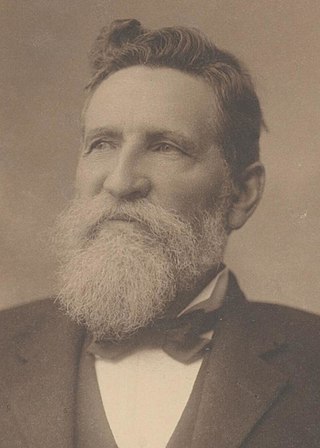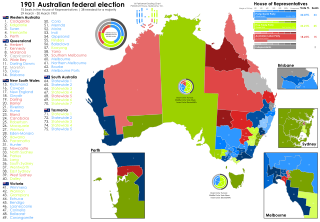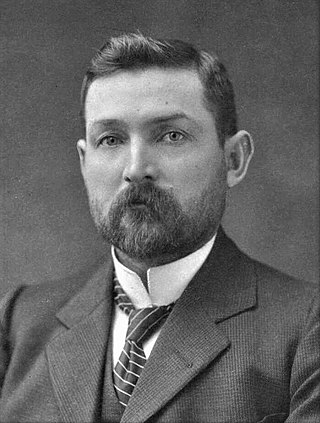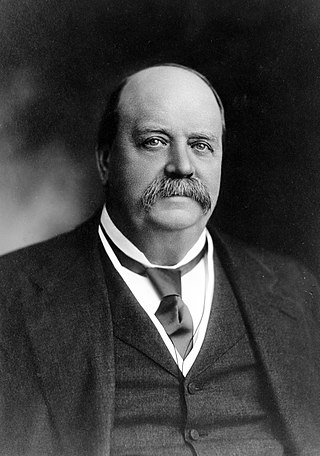
John Christian Watson was an Australian politician who was the third prime minister of Australia, in office from 27 April to 18 August 1904. He was the inaugural federal leader of the Australian Labor Party (ALP) from 1901 to 1907 and was the first member of the party to serve as prime minister.

Sir George Houston Reid was an Australian politician, diplomat and barrister who served as the fourth prime minister of Australia, from 1904 to 1905, holding office as the leader of the Free Trade Party. He previously served as the 12th premier of New South Wales from 1894 to 1899, and later the High Commissioner to the United Kingdom of Australia from 1910 to 1916.
The Free Trade Party, officially known as the Australian Free Trade and Liberal Association, also referred to as the Revenue Tariff Party in some states, was an Australian political party, formally organised in 1887 in New South Wales, in time for the 1887 colony election, which the party won. It advocated the abolition of protectionism, especially protective tariffs and other restrictions on trade, arguing that this would create greater prosperity for all. However, many members also advocated use of minimal tariffs for government revenue purposes only. Its most prominent leader was George Reid, who led the Reid government as the fourth Prime Minister of Australia (1904–05). In New South Wales it was succeeded by the Liberal and Reform Association in 1902, and federally by the Anti-Socialist Party in 1906. In 1909, the Anti-Socialist Party merged with the Protectionist Party to form the Commonwealth Liberal Party.
The Protectionist Party, also known as the Protectionist Liberal Party or Liberal Protectionist Party, was an Australian political party, formally organised from 1887 until 1909, with policies centred on protectionism. The party advocated protective tariffs, arguing it would allow Australian industry to grow and provide employment. It had its greatest strength in Victoria and in the rural areas of New South Wales. Its most prominent leaders were Sir Edmund Barton and Alfred Deakin, who were the first and second prime ministers of Australia.

Sir William John Lyne KCMG was an Australian politician who served as Premier of New South Wales from 1899 to 1901, and later as a federal cabinet minister under Edmund Barton and Alfred Deakin. He is best known as the subject of the so called "Hopetoun Blunder", unexpectedly being asked to serve as the first Prime Minister of Australia but proving unable to form a government.
This is a list of the members of the Australian House of Representatives in the First Australian Parliament, which was elected on 29 and 30 March 1901. There were 75 members, as required by the Constitution, as near as possible to twice the number of Senators which was then 36. South Australia and Tasmania had not been divided into electoral divisions in 1901 which resulted in the particular state voting as a single electorate. There were seven members for South Australia, and five members for Tasmania elected.

Allan McLean was an Australian politician who served as the 19th Premier of Victoria, in office from 1899 to 1900. He was later elected to federal parliament, where he served as a government minister under George Reid.

The 1901 Australian federal election for the inaugural Parliament of Australia was held in Australia on Friday 29 March and Saturday 30 March 1901. The elections followed Federation and the establishment of the Commonwealth of Australia on 1 January 1901. All 75 seats in the Australian House of Representatives, six of which were uncontested, as well as all 36 seats in the Australian Senate, were up for election.

The 1906 Australian federal election was held in Australia on 12 December 1906. All 75 seats in the House of Representatives, and 18 of the 36 seats in the Senate were up for election. The incumbent Protectionist Party minority government led by Prime Minister Alfred Deakin retained government, despite winning the fewest House of Representatives votes and seats of the three parties. Parliamentary support was provided by the Labour Party led by Chris Watson, while the Anti-Socialist Party, led by George Reid, remained in opposition.

The 1910 Australian federal election was held in Australia on 13 April 1910. All 75 seats in the House of Representatives, and 18 of the 36 seats in the Senate were up for election. The incumbent Liberal Party led by Prime Minister Alfred Deakin was defeated by the opposition Australian Labor Party (ALP) led by Andrew Fisher.

David Storrer was an Australian politician.
This article provides information on candidates who stood for the 1901 Australian federal election. The election was held on 29/30 March 1901.
This article provides information on candidates who stood for the 1903 Australian federal election. The election was held on 16 December 1903.
This article provides information on candidates who stood for the 1906 Australian federal election. The election was held on 12 December 1906.
This is a list of members of the Australian Senate from 1907 to 1910. Half of its members were elected at the 16 December 1903 election and had terms starting on 1 January 1904 and finishing on 30 June 1910; the other half were elected at the 12 December 1906 election and had terms starting on 1 January 1907 and finishing on 30 June 1913. They had an extended term as a result of the 1906 referendum, which changed Senate terms to finish on 30 June, rather than 31 December.

The Barton government was the first federal executive government of the Commonwealth of Australia. It was led by Prime Minister Sir Edmund Barton, from 1 January 1901 until 24 September 1903, when Barton resigned to become one of the three founding judges of the High Court of Australia.
The following tables show state-by-state results in the Australian Senate at the 1901 federal election. Senators total 17 Free Trade, 11 Protectionist, and eight Labour. The terms were deemed to start on 1 January 1901. In each state, the first three elected received full six-year terms, and the three senators elected with the lowest number of votes retire after three years.
The history of the Australian Labor Party has its origins in the Labour parties founded in the 1890s in the Australian colonies prior to federation. Labor tradition ascribes the founding of Queensland Labour to a meeting of striking pastoral workers under a ghost gum tree in Barcaldine, Queensland in 1891. The Balmain, New South Wales branch of the party claims to be the oldest in Australia. Labour as a parliamentary party dates from 1891 in New South Wales and South Australia, 1893 in Queensland, and later in the other colonies.

The Watson government was the third federal executive government of the Commonwealth of Australia. It was led by Prime Minister Chris Watson of the Australian Labor Party from 27 April 1904 to 18 August 1904. The Watson government was the first Labor Party national government in both Australia and in the world. Watson was aged just 37 when he became Prime Minister of Australia, and remains the youngest person to have held the post.

The Reid government refers to the period of federal executive government of Australia led by Prime Minister George Reid. It lasted from 18 August 1904 - 5 July 1905. Reid was the sole Prime Minister of Australia to belong to the Free Trade Party. Allan McLean of the Protectionist Party served as deputy.


















